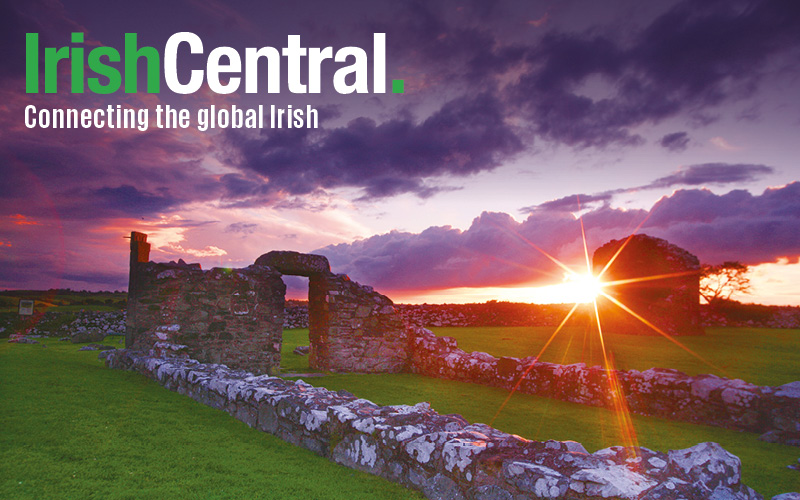In Galway, a city of just under 80,000 souls, the late Mark Kennedy always stood out from the crowd. Not many 79-year-olds can be found bopping around at the front of heavy metal gigs, but few people of any age have lived lives as full or interesting as the colorful pensioner who passed away in October 2016.
From being a well-paid Hollywood writer in the 1960s to a homeless street drinker in the early 1990s, and on to become one of the most vocal campaigners for social justice in his native city, Mark had an amazing life.
Born into poverty in a working-class part of the city in 1937, he embarked on a life of adventure after leaving school at just 13 years of age. He has left a lasting legacy in the form of a Famine Memorial Park on the shores of Galway Bay.
Mark campaigned for years to make sure that his city would build a memorial to all of those who lost their lives in the Great Famine in the 1840s and the hundreds of thousands of impoverished emigrants who set sail from Galway Bay for new lives in the Americas.
When it came to politicians and bureaucrats, he would never take “no” for an answer as he insisted upon the importance of remembering the troubled history of the West of Ireland and all those who were forced to leave.

The Celia Griffin famine memorial park overlooking Galway Bay.
Poignantly, he called the park after Celia Griffin, after discovering the story of a little six-year-old girl who lost her life just meters from the seafront in the old fishing village of the Claddagh.
The opening of the park in July 2012 was a personal triumph for Mark, not that he ever wanted the limelight or to be seen as a “celebrity” in the city.
He had worked on the project for years. He wanted a monument to the 100 famine ships which sailed out of Galway between 1847 and 1850 when thousands upon thousands of people across Ireland were dying of starvation.
These ships saved the lives of thousands of people and Mark felt it was important to remember this terrible period in Galway’s history, even if the local authorities in the city and county did not always agree with his plans.
His achievement in opening the park was all the more remarkable because he had made such a huge effort to turn his own life around.
When I first met Mark in the early 1990s, he was a homeless street drinker in a city where the party never seemed to stop and many people died young due to alcoholism.
Street drinkers had a visible presence in the city center throughout the year and Mark campaigned for their rights when businesses, worried about the impact on tourism, wanted to clear them away from public view.
After the break-up of his second marriage, Mark had returned home to Galway at the end of the 1980s.
He worked on a couple of documentaries with a good friend, the late Niall Hughes. ‘Horselands’ and ‘Clear the Streets’ explored a hidden Galway which never made it into the tourist brochures.
Young people in Galway were in awe of Mark because they knew he had earned good money as a Hollywood writer in the 1960s.
He had worked on films such as ‘Roar’ (which was eventually released in 1981) and ‘The Exorcist’ and had been on a commission of $600 a week from MGM, when $600 a week was considered a lot of money.
Mark was homeless himself when he made his documentary about homelessness in Galway and, in later years, he would talk candidly about what it was like to lose everything, including his family, a home, and a job, in his battle with the booze.
Childhood poverty, and meeting many emigrants who had been wounded by their childhoods in Ireland, turned Mark into a life-long fighter for social justice.
He raged against injustice and inequality and said it was important to highlight issues such as homelessness, which others felt were best ignored.
“I recall going to school hungry, and seeing other children faint from hunger,” he once said. “Tea and bread was the staple diet.”
He joined the army for two years and, like so many from the West of Ireland, he emigrated to Britain at just 19 years of age. In Liverpool, he heard horrific stories of abuse back home from people who were forced to emigrate in search of work.
He moved to Canada in 1966 and, after his successful spell in Hollywood, he left California in 1969 when his second wife, Ann, wanted a more simple life for their two children.
They returned to Ireland because they felt that the US was “too obsessed with success and failure”, but Mark lost everything because of the drink by the late 1980s.
Together with a group of street drinkers, Mark would bed down for the night in a shop doorway or a site at the back of the city’s railway station. Friends used to offer him a couch to sleep on, but they couldn’t keep him for long because of the extent of his drinking.
And then, on one cold night in 1992, he had a moment of clarity as he sat in Galway city center drinking a bottle of tonic wine.
“I was drinking Buckfast in Church Lane, near St Nicholas’ Cathedral, when I just heard a voice in my head saying: ‘You can’t leave this as a legacy to your children and grandchildren’,” he later recalled. “I just put the bottle down, and walked away from it.”
And that was it. Mark never drank again, and he set about turning his life around.
His good friend John Herrick, a sign-writer, offered Mark some work and he managed to get a comfortable little flat on the eastern side of the city, in Renmore.

Mark Kennedy in the show at the top of Croagh Patrick
Sober now, he became an inspiration to many others. He organized campaigns on behalf of the elderly and the homeless, becoming something of a thorn in the side of the local authorities in Galway.
He was a leader on a huge nationwide protest on behalf of the elderly, organized by Age Action, eight years ago.
Mark didn't judge anyone, because he had experienced rock bottom himself, but he became an unofficial counseling service.
As a former emigrant, he was always hugely interested in injustice and the way things can be brushed under the carpet back in Ireland.
He wanted to know why there was no monument to the victims of the Great Famine in Galway or why the city had failed to honor all those who left Galway Bay on the “coffin ships” to America.
He put his heart and soul into a new project, which eventually led to the construction of the beautiful Celia Griffin Memorial Park on the shores of the bay.
It's a fitting tribute to a Galway legend, a wonderful landmark for the city and an uncomfortable reminder of our troubled past.
Mark liked to challenge those in power and to make the powerful feel uncomfortable throughout his hugely interesting life.
He enjoyed a whole new lease of life after giving up alcohol and, at 65 years of age, he began to study at NUI Galway. Mark graduated with a first class honors BA in History and English and went on to complete a PhD on the 16th century landed gentry.
Being sober did not keep him away from Galway’s hectic social life and, in recent years, he's been a regular at music gigs at the city’s best music venue, the Roisin Dubh.
Wearing a distinctive cap, festooned in badges, and dark glasses he would immerse himself in heavy metal and punk music gigs, delighting the much younger fans around him at the Roisin.
He never wanted to become boring or conservative and had a whole new collection of young friends on the city’s music scene.
Since he turned 70, his birthday became an annual expedition with a group of friends to Croagh Patrick in Co. Mayo, considered the holiest place in the West of Ireland. He showed remarkable good health by climbing to the top of the mountain each year.

Mark Kennedy with Eoghan 'Gugai' McNamara of the Roisin Dubh
He was truly one of a kind and his beautiful park on the shores of Galway Bay has left a wonderful lasting legacy to his native city.
Ciaran Tierney is a journalist, blogger, and digital storyteller based in Galway, Ireland. You can find his Facebook page here.
* Originally published in October 2016.
This article was submitted to the IrishCentral contributors network by a member of the global Irish community. To become an IrishCentral contributor click here.




Comments